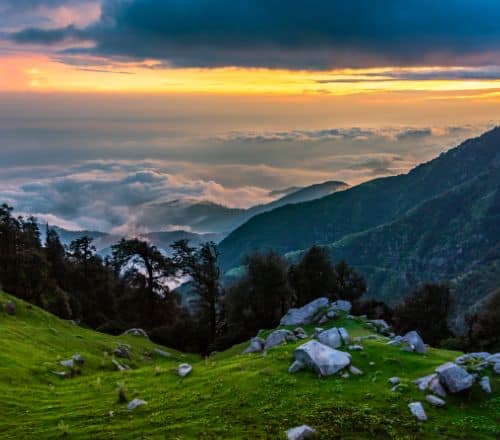Stay logged in to proceed with bookings, orders and offers.
On changing the terminal, you will loose items in your cart. Are you sure you want to change your terminal?
My quest to catch a glimpse of Maya, the majestic Bengal Tigress who rules Tadoba
When your city-frayed nerves get the better of you, taking a turn off the beaten track is often the best remedy. Tired and worn out by my routine, I decided to heed the call of the wild and escape – from the concrete jungle into the real jungle.
Tucked away about 140 km. southeast of the bustling city of Nagpur in Chandrapur, Maharashtra, Tadoba National Park is among India's 47 Project Tiger Reserves. Filled with deep valleys, lush forests, and green meadows, Tadoba National Park is one of the last strongholds of the Royal Bengal Tiger, the apex predator of the Indian subcontinent.
Mixed awe and wonder feed into the thrill of a tiger safari. It's an incredible adventure – you never know what you'll spot around the bend. My heart races at the thought of facing off with the powerful predator in its natural habitat as I stand aboard an open four-wheel drive – instead of watching it loll about in a zoo enclosure.
'Same jungle, same animals… where's the fun?' quipped my friends and family when I discussed my plans with them. But only a true nature-lover understands the wealth of experiences that nature bestows upon us.
Read More
Read Less
Come winter, the forests of Tadoba National Park are a sight to behold. Sunrays bathe the rainwashed greens in soft golden light. It's the perfect setup for capturing shots in the wild. On my journey toward becoming a professional portrait photographer, I have learned much from wildlife photography. My obsession with national parks started in 2013, with my first trip to Ranthambore National Park. There, I experienced my first sighting of a striped big cat – and there was no looking back. This time, my goal was to spot Maya, the famous tigress of Tadoba, popularly known as the 'Queen of Tadoba'.
I decided to take the Duronto Express to Nagpur, followed by a three-hour drive to Tadoba National Park. As we drove, the landscape transitioned from the urban struggle of concrete buildings into the scrub and dirt roads of the countryside. Staring out of the window, I couldn't help but draw an analogy with life – its constant changes, its unexpected scenery. We spend so much time focused on the road ahead, on moving in the right direction. But do we miss out on the beautiful views passing us by?
My reverie was rudely interrupted as the vehicle began to judder. We'd hit the rough, bumpy roads of the hinterland surrounding the national park. This is where the boundaries between nature and civilization tend to blur, with humans and animals largely co-existing in peace. Spotting the shimmering waters of Irai Lake in the distance, I knew we were close to the park. I could not wait to hop aboard my tiger safari!
The next morning, I sat bolt upright as my alarm screeched through the forest silence. It was time. We headed out for the safari, all bundled up in warm clothes. There was a flurry of activity outside the gates – guides, drivers, and tea-stall owners, all fully awake and hard at work in the wee hours of the morning. Life in the lap of nature is as uncertain as it is rewarding, with most people's livelihoods depending on the seasonality of tourism.
Soon the gates opened, and off we went! The blue hour was lightening, golden rays of dawn streaming through the trees. A flock of parakeets flew overhead, welcoming the new day with loud calls. As we drove through the forest, a herd of spotted deer gave us nonchalant glances before continuing to graze. Our guide and driver had their eyes set on the dirt track ahead, their keen ears picking up the slightest sound from any direction. These local experts know every square inch of the park and have a profound understanding of animal behaviour. I cannot thank them enough for their invaluable aid in our quest to catch sight of Maya.
At the time of our visit, Maya had just given birth to two cubs. Aged more than 13 years, the fearless and dominating tigress of Pandharpauni was our reason for embarking on this safari. Tadoba National Park is home to as many as 88 tigers, of which Maya is the most famous. As the morning mist parted before our cantor, the wistful calls of peacocks echoed through the forest. Further ahead, we spotted a group of langurs chattering away. They appeared to be fighting over whose turn it was to be groomed! The forest's denizens were waking up to a new day, and my heart rose with hope for our purpose.
The first step towards spotting a tiger is understanding the jungle terrain. That said, there's nothing too complicated about scouring the jungle for 'intelligence'. All you need is keen observation and an acceptance of nature’s ways.
We scoured the dirt tracks for pugmarks, attuning our ears to the alarm calls of sambar deer or spotted deer. In other situations, we strained our eyes to spot crushed grass, which would indicate where a tiger had laid down at night. Tigers are crepuscular by nature, which means that they are active at dusk and dawn. This makes the early morning a favourable time for on-the-move tiger sightings.
As the hours rolled by, the sun began to penetrate the thick foliage. We reached Maya's territory, but there was no sign of her. Everything was absolutely still – it seemed the tiger family was away on holiday! We waited at a waterhole, hoping thirst would draw Maya and her cubs there. We weren't disappointed – we saw a herd of wild gaur enjoying an early-morning dip, white egrets pecking a breakfast of flies and insects off their backs. It was a beautiful scene, the symbiotic relationship between two entirely different species. The jungle brings us so much wisdom – lessons you can't learn in any classroom.
As we watched the gaur, the silence was broken by a shrill ponk – it was the call of a sambar deer. All around us, the jungle began to stir and rustle. We scrambled to take off in the direction of the call. With their acute sense of smell and hearing, sambar deer are quick to identify the presence of a predator.
Then came another call – khee-khee-khee, this time from the trees. The langurs had spotted a predator too and were warning everyone. Now reluctant to move, we stood with bated breath. Several seconds passed – and then the tall grass parted, and the regal beauty slowly emerged before our eyes.
There stood Maya, bold and beautiful as ever, her coat shining in the dappled light. She shot a glance at us, swiftly sensing that we were harmless bystanders. Satisfied, she turned around and gave a gentle roar. One cub and then another stepped out of the bushes, both somewhat unsure, eying us warily. But seeing their mother’s confidence in our presence, they ambled along behind her. It looked like they were thirsty, and the only thing on their minds was drinking from the waterhole. As Maya sauntered down the dirt road, it was clear why the title of the 'Queen of Tadoba' had been bestowed upon her, of all the big cats here.
The cubs splashed about in the water while Maya looked on. They had their fill of water and, re-energized, started wrestling with each other. These raw, perfect moments in the wild were my reason for embarking on this safari. I slipped into a state of nervous excitement as I captured the scene from all possible angles. After I had taken pictures to my heart’s content, I decided to put down my camera and simply be present in this incredible moment.
For a second, Maya’s eyes met mine. What passed between us was an ineffable sense of trust and respect. She seemed to say, 'You go your way, I will go mine, and we will be fine.'
Bookings for the tiger safari open around four months in advance and sell out very fast, so be sure to plan your trip to Tadoba well in advance. You can book different safaris for exploring the various zones of the park. It's a good idea to research zone-wise sightings before booking your safari of choice.
Consider booking a night safari – it is the best way to see the nocturnal wildlife in the jungle. The park's buffer zones offer several great activities, such as boating, kayaking, cycling, nature camping, overnight machaan stays, birding machaans, a visit to the butterfly garden, and much more. Focus on making the most of the overall jungle experience – the jungle has much more to offer than tiger sightings.
The nearest major city to Tadoba National Park is Nagpur, which is situated around 140 km. northwest of the national park. Nagpur Airport is located around 8 km. southwest of the city centre. The nearest railway station is Chandrapur, which is around 35 km. south of the national park.





The Adani One expressly disclaims all liability, direct and indirect, in respect to actions taken or not taken based on any or all the contents of this Blog. The Blog is an opinion of the contributor based on the collation of data from various sources and is provided only for information purpose. Adani One does not canvass, advertise, solicit, invite or induct for any product, merchandise, information, brand or any other materials mentioned in the Blog, nor does it obtain any monetary benefit from the same. Reader is advised to read and apply his/her intellect and discretion in this regard. Any Intellectual Property mentioned in this blog belongs to the rightful owner. We do not intent to claim any interest over the same.